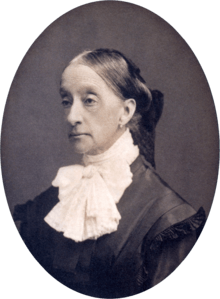Princess Francisca of Brazil
| Princess Francisca | |||||
|---|---|---|---|---|---|
| Princess of Joinville | |||||
 Dona Francisca around age 56, c.1880 | |||||
| Born |
2 August 1824 Palace of São Cristóvão, Rio de Janeiro, Empire of Brazil | ||||
| Died |
27 March 1898 (aged 73) Paris, France | ||||
| Burial | Royal Chapel, Dreux, France | ||||
| Spouse | Prince François, Prince of Joinville (m. 1843–1898; her death) | ||||
| Issue Detail |
Princess Françoise, Duchess of Chartres Prince Pierre, Duke of Penthièvre Princess Marie Léopoldine | ||||
| |||||
| House | Braganza | ||||
| Father | Pedro I of Brazil | ||||
| Mother | Maria Leopoldina of Austria | ||||
| Religion | Roman Catholic | ||||
| Signature |
| ||||
Dona Francisca (2 August 1824 – 27 March 1898) was a princess of the Empire of Brazil. She was a daughter of Emperor Dom Pedro I, who also reigned as King Dom Pedro IV of Portugal, and his first wife, Dona Maria Leopoldina. She married a son of Louis Philippe I and had three children. Through her only surviving daughter, she is an ancestor of Prince Henri, Count of Paris, the present Orléanist pretender to the French throne.
Biography


Francisca was born on 2 August 1824 in the Palace of São Cristóvão, in Rio de Janeiro, capital of the Empire of Brazil. Her name in full was Francisca Carolina Joana Carlota Leopoldina Romana Xavier de Paula Micaela Gabriela Rafaela Gonzaga.[1] Through her father, Emperor Dom Pedro I, she was a member of the Brazilian branch of the House of Braganza (Portuguese: Bragança) and was referred to using the honorific "Dona" (Lady) from birth.[2] Her mother was the Archduchess Maria Leopoldina of Austria, daughter of Franz II, the last Holy Roman Emperor. Through her, Francisca was a niece of Napoleon Bonaparte and first cousin of Emperors Napoleon II of France, Franz Joseph I (Francis Joseph I) of Austria-Hungary and Don Maximiliano I (Maximilian I) of Mexico.[3]
Francisca married Prince François of Orléans, third son of Louis Philippe I and his Italian Queen Maria Amalia of Naples. François, called the Prince of Joinville, and Francisca married in Rio de Janeiro on 1 May 1843. The bride was 19, the groom 25. Her portrait was painted when she arrived in Paris, in 1844, by Ary Scheffer (coll. Musée de la Vie romantique, Paris).
Their only daughter Princess Françoise of Orléans married her first cousin Prince Robert, Duke of Chartres and became the mother of the Orléanist pretender Prince Jean, Duke of Guise. Her son Pierre never married, but had two illegitimate children by a married woman..
When the Orléans family fled France, they settled in England living at Claremont; It was there that Francisca gave birth to a still born daughter in 1849; the next year, the exiled King Louis Philippe I died himself. After the fall of the House of Bonaparte of the Second Empire, the Orléans family returned to France; Francisca herself died in Paris aged 73. Her husband outlived her by two years, dying in Paris in 1900.
Issue
- Princess Françoise of Orléans (14 August 1844 – 28 October 1925) married her cousin Prince Robert, Duke of Chartres and had issue.
- Prince Pierre, Duke of Penthièvre (4 November 1845 – 17 July 1919) never married.
- Princess Marie Léopoldine of Orléans (30 October 1849) stillborn daughter born at Claremont.
Titles and styles
- 2 August 1824 – 1 May 1843: Her Highness Princess Francisca of Brazil
- 30 May 1837 – 27 March 1898: Her Royal Highness The Princess of Joinville
Ancestry
| Ancestors of Princess Francisca of Brazil | ||||||||||||||||||||||||||||||||||||||||||||||||||||||||||||||||||||||||||||||||||||||||||||||||||||||||||||||||||||||||||||||||||||||||||||||||||||||||||||||||||||||||||||||||||||||||||||||||||||||||||||||||||||||||||||||||||||||||||||||||||||||||||||||||||||||||||||||||||||||||||||||||||||||||||||||||||||||||||||||||||||||||||||||||||||||||||||||||||||||||||||||||||||||||||||||||||||||||||||||||||||||||||||||||||||||||||||||||||||||||||||||||||||||||||||||||||||||||||||||||||||||||||||||||||||||||||||||||||
|---|---|---|---|---|---|---|---|---|---|---|---|---|---|---|---|---|---|---|---|---|---|---|---|---|---|---|---|---|---|---|---|---|---|---|---|---|---|---|---|---|---|---|---|---|---|---|---|---|---|---|---|---|---|---|---|---|---|---|---|---|---|---|---|---|---|---|---|---|---|---|---|---|---|---|---|---|---|---|---|---|---|---|---|---|---|---|---|---|---|---|---|---|---|---|---|---|---|---|---|---|---|---|---|---|---|---|---|---|---|---|---|---|---|---|---|---|---|---|---|---|---|---|---|---|---|---|---|---|---|---|---|---|---|---|---|---|---|---|---|---|---|---|---|---|---|---|---|---|---|---|---|---|---|---|---|---|---|---|---|---|---|---|---|---|---|---|---|---|---|---|---|---|---|---|---|---|---|---|---|---|---|---|---|---|---|---|---|---|---|---|---|---|---|---|---|---|---|---|---|---|---|---|---|---|---|---|---|---|---|---|---|---|---|---|---|---|---|---|---|---|---|---|---|---|---|---|---|---|---|---|---|---|---|---|---|---|---|---|---|---|---|---|---|---|---|---|---|---|---|---|---|---|---|---|---|---|---|---|---|---|---|---|---|---|---|---|---|---|---|---|---|---|---|---|---|---|---|---|---|---|---|---|---|---|---|---|---|---|---|---|---|---|---|---|---|---|---|---|---|---|---|---|---|---|---|---|---|---|---|---|---|---|---|---|---|---|---|---|---|---|---|---|---|---|---|---|---|---|---|---|---|---|---|---|---|---|---|---|---|---|---|---|---|---|---|---|---|---|---|---|---|---|---|---|---|---|---|---|---|---|---|---|---|---|---|---|---|---|---|---|---|---|---|---|---|---|---|---|---|---|---|---|---|---|---|---|---|---|---|---|---|---|---|---|---|---|---|---|---|---|---|---|---|---|---|---|---|---|---|---|---|---|---|---|---|---|---|---|---|---|---|---|---|---|---|---|---|---|---|---|---|---|---|---|---|---|---|---|---|---|---|---|---|---|---|---|---|---|---|---|---|---|---|---|---|---|---|---|---|---|---|---|---|---|---|---|---|---|---|---|---|---|---|---|---|---|---|---|---|---|---|---|---|---|---|---|---|---|---|---|---|---|---|---|---|---|---|---|---|---|---|---|---|---|---|---|---|---|---|---|---|---|---|---|
| ||||||||||||||||||||||||||||||||||||||||||||||||||||||||||||||||||||||||||||||||||||||||||||||||||||||||||||||||||||||||||||||||||||||||||||||||||||||||||||||||||||||||||||||||||||||||||||||||||||||||||||||||||||||||||||||||||||||||||||||||||||||||||||||||||||||||||||||||||||||||||||||||||||||||||||||||||||||||||||||||||||||||||||||||||||||||||||||||||||||||||||||||||||||||||||||||||||||||||||||||||||||||||||||||||||||||||||||||||||||||||||||||||||||||||||||||||||||||||||||||||||||||||||||||||||||||||||||||||
Footnotes
- ↑ Sauer 1889, p. 43.
- ↑ Barman 1999, p. 424.
- ↑ Barman 1999, p. 1.
- ↑ Barman (1999), p.8
References
External links
| Wikimedia Commons has media related to Princess Francisca of Brazil. |
.svg.png)

